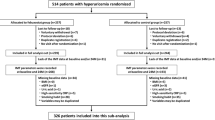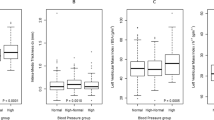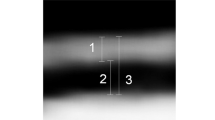Abstract
The association between pre-hypertension (pre-HTN) and subclinical carotid damage is poorly defined. We performed a meta-analysis of ultrasonographic studies assessing carotid intima-media thickness (IMT) in untreated pre-HTN subjects. The OVID-MEDLINE, PubMed, and Cochrane CENTRAL databases were searched for English-language articles without time restriction up to February 2018 through focused, high sensitive search strategies. Studies were identified by crossing the following search terms: “pre-hypertension”, “high normal blood pressure”, “carotid intima-media thickness”, “carotid atherosclerosis”, “ultrasonography”. Overall, 7645 subjects (3374 normotensive, 1936 untreated pre-HTN, and 2335 HTN individuals) of both genders were included in seven studies. In the pooled study population, common carotid IMT showed a progressive increase from normotensive (723 ± 39 µm) to pre-HTN (779 ± 45 µm) (standardized mean difference, SMD 0.36 ± 0.08, CI 0.34–0.46, p < 0.0001) and to HTN subjects (858 ± 82 µm) (SMD 0.39 ± 0.07, CI 0.26–0.54, p = 0.002 vs. pre-HT). The statistical difference did not change after correction for publication bias and was not affected by a single study effect. Our meta-analysis shows that carotid IMT in pre-HTN subjects is intermediate between normotensive and HTN individuals. These findings support the view that pre-HTN is an unfavourable condition that should be properly managed in order to prevent vascular damage.
This is a preview of subscription content, access via your institution
Access options
Subscribe to this journal
Receive 12 digital issues and online access to articles
$119.00 per year
only $9.92 per issue
Buy this article
- Purchase on Springer Link
- Instant access to full article PDF
Prices may be subject to local taxes which are calculated during checkout



Similar content being viewed by others
References
Mancia G, Fagard R, Narkiewicz K, Redon J, Zanchetti A, Bohm M, et al. 2013 ESH/ESC Guidelines for the management of arterial hypertension. The Task Force for the management of arterial hypertension of the European Society of Hypertension (ESH) and of the European Society of Cardiology (ESC). J Hypertens. 2013;31:1281–357.
Pierdomenico SD, Cuccurullo F. Risk reduction after regression of echocardiographic left ventricular hypertrophy in hypertension: a meta-analysis. Am J Hypertens. 2010;23:876–81.
Bang CN, Devereux RB, Okin PM. Regression of electrocardiographic left ventricular hypertrophy or strain is associated with lower incidence of cardiovascular morbidity and mortality in hypertensive patients independent of blood pressure reduction - A LIFE review. J Electrocardiol. 2014;47:630–5.
Cuspidi C, Meani S, Valerio C, Esposito A, Sala C, Maisaidi M, et al. Ambulatory blood pressure, target organ damage and aortic root size in never-treated essential hypertensive patients. J Hum Hypertens. 2007;21:531–8.
Lewington S, Clarke R, Qizilbash N, Peto R, Collins R. Age-specific relevance of usual blood pressure to vascular mortality: a meta-analysis of individual data for one million adults in 61 prospective studies. Lancet. 2002;360:1903–13.
Chrysohoou C, Pitsavos C, Panagiotakos DB, Skoumas J, Stefanadis C. Association between prehypertension status and inflammatory markers related to atherosclerotic disease. The ATTICA Study. Am J Hypertens. 2004;17:568–73.
Garofalo C, Borrelli S, Pacilio M, Minutolo R, Chiodini P, De Nicola L, et al. Hypertension and prehypertension and prediction of development of decreased estimated GFR in the general population: a meta-analysis of cohort studies. Am J Kidney Dis. 2016;67:89–97.
Chobanian AV, Bakris GL, Black HR, Cushman WC, Green LA, Izzo JL Jr, et al. National High Blood Pressure Education Program Coordinating Committee. The seventh report of the Joint National Committee on Prevention, Detection, Evaluation and Treatment of High Blood Pressure. Hypertension. 2003;42:1206–52.
Soliman EZ, Ambrosius WT, Cushman WC, Zhang ZM, Bates JT, Neyra JA, et al. SPRINT Research Study Group. Effect of intensive blood pressure lowering on left ventricular hypertrophy in patients with hypertension: SPRINT (Systolic Blood Pressure Intervention Trial). Circulation. 2017;136:440–50.
Tadic M, Majstorovic A, Pencic B, Ivanovic B, Neskovic A, Badano L, et al. The impact of high-normal blood pressure on left ventricular mechanics: a three-dimensional and speckle tracking echocardiography study. Int J Cardiovasc Imaging. 2014;30:699–711.
Jang SY, Kim S, Lee CK, Cho EJ, Cho SJ, Lee SC. Pre-hypertension and left ventricular diastolic dysfunction in middle-aged Koreans. Korean Circ J. 2016;46:536–41.
Santos ABS, Gupta DK, Bello NA, Gori M, Claggett B, Fuchs FD, et al. Pre-hypertension is associated with abnormalities of cardiac structure and function in the atherosclerosis risk in communities study. Am J Hypertens. 2016;29:568–74.
Hald EM, Lijfering WM, Mathiesen EB, Johnsen SH, Løchen ML, Njølstad I, et al. Carotid atherosclerosis predicts future myocardial infarction but not venous thromboembolism: the Tromso Study. Arterioscler Thromb Vasc Biol. 2014;34:226–3.
Baldassarre D, Veglia F, Hamsten A, Humphries SE, Rauramaa R, de Faire U, et al. IMPROVE Study Group. Progression of carotid intima-media thickness as predictor of vascular events: results from the IMPROVE study. Arterioscler Thromb Vasc Biol. 2013;33:2273–9.
Moher D, Liberati A, Tetzlaff J, Altman, DG PRISMA Group. Preferred reporting items for systematic reviews and meta-analyses: the PRISMA statement. BMJ (Clinical Research ed). 2009; 339, b2535.
Manios E, Tsivgoulis G, Koroboki E, Stamatelopoulos K, Papamichael C, Toumanidis S, et al. Impact of prehypertension on common carotid artery intima-media thickness and left ventricular mass. Stroke. 2009;40:1515–8.
Toprak A, Wang H, Chen W, Paul T, Ruan L, Srinivasan S, et al. Pre-hypertension and black–white contrasts in cardiovascular risk in young adults: Bogalusa Heart Study. J Hypertens. 2009;27:243–50.
Tan JR, Chen YH, Bi YF, Xu M, Huang Y, Dai M, et al. Prehypertension is associated with atherosclerosis in Type 2 diabetes. J Diabetes. 2010;2:56–63.
Kim SH, Cho GY, Baik I, Lim SY, Choi CU, Lim HE, et al. Early abnormalities of cardiovascular structure and function in middle-aged Korean adults with pre-hypertension: The Korean Genome Epidemiology Study. Am J Hypertens. 2011;24:218–24.
Urbina EM, Khoury PR, McCoy C, Daniels SR, Kimball TR, Dolan LM. Cardiac and vascular consequences of pre-hypertension in youth. J Clin Hypertens. 2011;13:332–42.
Hong H, Wang H, Liao H. Prehypertension is associated with increased carotid atherosclerotic plaque in the community population of Southern China. BMC Cardiovasc Disord. 2013;13:20.
Sung SH, Cheng HM, Wang KL, Yu WC, Chuang SY, Ting CT, et al. White coat hypertension is more risky than pre hypertension: important role of arterial wave reflections. Hypertension. 2013;61:1346–53.
Pignoli P, Tremoli E, Poli A, Oreste P, Paoletti R. Intimal plus medial thickness of arterial wall: a direct measurement with ultrasound imaging. Circulation. 1986;74:1399–408.
Salonen R, Haapanen A, Salonen JM. Measurement of intima-media thickness of common carotid arteries with high resolution B-mode ultrasonography: inter- and intra-observer variability. Ultrasound Med Biol. 1991;17:225–30.
Wang Y, Wang QJ. The prevalence of prehypertension and hypertension among US adults according to the new Joint National Committee guidelines: new challenges of the old problem. Arch Intern Med. 2004;164:2126–34.
Tsai PS, Ke TL, Huang CJ, Tsai JC, Chen PL, Wang SY, et al. Prevalence and determinants of pre-hypertension status in the Taiwanese general population. J Hypertens. 2005;23:1355–60.
Grotto I, Grossman E, Huerta M, Sharabi Y. Prevalence of pre-hypertension and associated cardiovascular risk profiles among young Israeli adults. Hypertension. 2006;48:254–9.
Whelton PK, Carey RM, Aronow WS, Casey DE Jr, Collins KJ, Dennison Himmelfarb C, et al. ACC/AHA/AAPA/ABC/ACPM/AGS/APhA/ASH/ASPC/NMA/PCNA Guideline for the Prevention, Detection, Evaluation, and Management of High Blood Pressure in Adults: A Report of the American College of Cardiology/American Heart Association Task Force on Clinical Practice Guidelines. Hypertension. 2017;2017:13. Nov
Natali A, Muscelli E, Casolaro A, Nilsson P, Melander O, Lalic N, et al. Metabolic characteristics of prehypertension: role of classification criteria and gender. J Hypertens. 2009;27:2394–402.
Zavodni AE, Wasserman BA, McClelland RL, Gomes AS, Folsom AR, Polak JF, et al. Carotid plaque morphology and composition in relation to incident cardiovascular events: The Multi-Ethnic Study of Atherosclerosis (MESA). Radiology. 2014;271:381–9.
Den Ruijter HM, Peters SA, Anderson TJ, Britton AR, Dekker JM, Eijkemans MJ, et al. Common carotid intima-media thickness measurements in cardiovascular risk prediction: a meta-analysis. JAMA. 2012;308:796–803.
Author information
Authors and Affiliations
Corresponding author
Ethics declarations
Conflict of interest
The authors declare that they have no conflict of interest.
Electronic supplementary material
Rights and permissions
About this article
Cite this article
Cuspidi, C., Sala, C., Tadic, M. et al. Pre-hypertension and subclinical carotid damage: a meta-analysis. J Hum Hypertens 33, 34–40 (2019). https://doi.org/10.1038/s41371-018-0114-6
Received:
Revised:
Accepted:
Published:
Issue Date:
DOI: https://doi.org/10.1038/s41371-018-0114-6
This article is cited by
-
Prevalence of hypertension mediated organ damage in subjects with high-normal blood pressure without known hypertension as well as cardiovascular and kidney disease
Journal of Human Hypertension (2022)
-
Association of carotid wall layers with atherosclerotic plaques and cardiac hypertrophy in hypertensive subjects
Journal of Human Hypertension (2022)
-
Effect of a 6-Month Controlled Lifestyle Intervention on Common Carotid Intima-Media Thickness
The Journal of nutrition, health and aging (2021)



